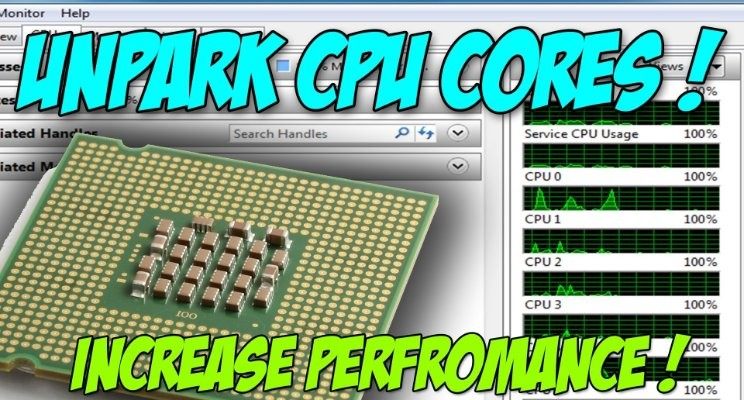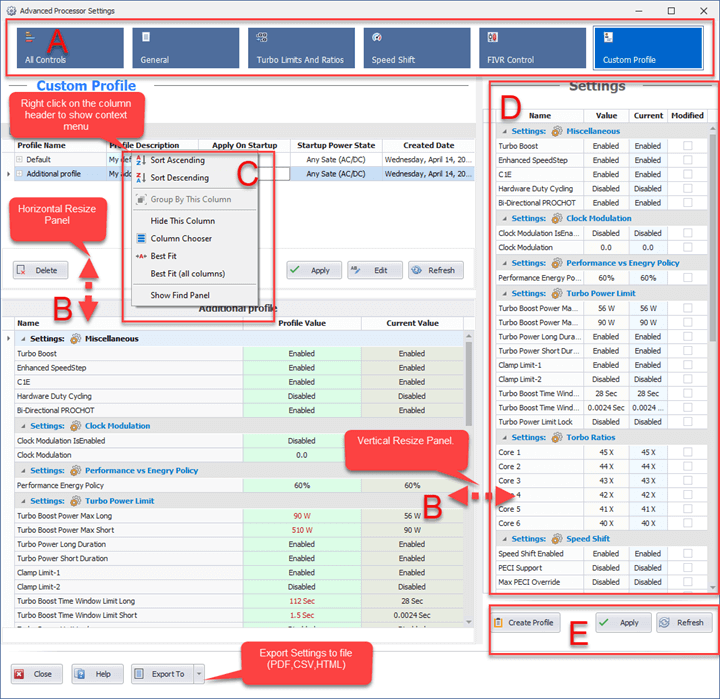CPU parking is a power-saving feature designed to reduce energy consumption by deactivating unused CPU cores. While this can be beneficial for extending battery life on laptops or reducing power consumption on desktops, it may hinder performance, especially for applications and tasks that require full CPU utilization. In scenarios such as gaming, video editing, or high-performance computing, having all CPU cores actively engaged can significantly boost overall performance.
“To unpark CPU cores, adjust power settings to ensure all cores are active, or use a tool like Quick CPU. This helps unlock full CPU performance, especially beneficial for demanding applications.”
In this article,We will discuss “How To Unpark Cpu Cores”
Table of Contents
What Does Unparking CPU Cores Mean:

CPU parking is a feature implemented in modern operating systems like Windows, designed to maximize power efficiency by temporarily disabling CPU cores that aren’t being used. These parked cores are not actively involved in processing tasks, which helps conserve power when the system isn’t under heavy load. However, in scenarios where maximum performance is required—such as video rendering, gaming, or running heavy applications—the CPU cores may need to be fully active to prevent slowdowns.
Unparking CPU cores means that all available cores are reactivated and can be used for processing tasks. This is crucial for ensuring that multi-threaded applications can fully utilize the available hardware, providing faster task execution and improved responsiveness. By unparking CPU cores, you can tap into the full potential of your processor, particularly when running resource-demanding programs.
Why Should You Unpark CPU Cores:
Improved Performance in Multi-threaded Applications:
Unparking CPU cores provides better performance in applications that use multiple threads, such as modern video games, 3D rendering, and data processing applications. These applications can offload tasks to multiple cores, speeding up overall processing and improving the user experience. When CPU cores are parked, only a subset of the CPU’s full potential is utilized, limiting performance in tasks that benefit from multi-core processing.
Increased Responsiveness and Reduced Latency:
When CPU cores are parked, the system might experience slight delays when transitioning between tasks or when new processes need to be handled. Unparking all cores can eliminate these delays, resulting in quicker load times and a more responsive system. This can be especially helpful for applications like web browsing, video editing, and virtual machine setups, where responsiveness is key.
Also Read: Proxmox CPU Type – Host, kvm64, Qemu64 & More!
Maximized CPU Utilization:
Many modern CPUs come with multiple cores, and when certain cores are parked, their processing power is wasted. By unparking these cores, you ensure that the CPU is being used to its full potential, allowing for the most efficient processing of tasks. This is especially beneficial in systems running multiple applications simultaneously or engaging in high-performance tasks.
How to Unpark CPU Cores in Windows:
There are several ways to unpark CPU cores in Windows, ranging from simple power setting adjustments to using third-party tools. Below are a few methods you can follow, depending on your preferences and level of expertise.
Using the Windows Power Options (Easy Method):
Windows provides a simple way to adjust power settings, which can unpark CPU cores. Here’s how you can do it:
- Open Power Options: Right-click on the Start menu and select “Power Options.”
- Choose High-Performance Plan: Under the Power Options window, you’ll see various power plans. Select the “High performance” plan. If you don’t see it, click on “Show additional plans” to make it visible.
- Adjust Processor Power Management: Click on “Change plan settings” next to the selected power plan, and then click “Change advanced power settings.”
- Modify Processor Power Management: In the Advanced Settings, scroll down to “Processor power management” and expand it.
- Set Minimum Processor State to 100%: Change the “Minimum processor state” value to 100% to ensure that all CPU cores are fully utilized. This will prevent any cores from being parked when the system is idle.
- Save Changes: Click “Apply” and then “OK” to save your settings.
This method is quick and effective for most users who want to unpark their cores without installing additional software.
Using Quick CPU Tool (Advanced Users):

For users who want more control and customization over their CPU’s behavior, Quick CPU is a powerful third-party tool that provides detailed options for managing CPU parking, among other performance settings.
- Download Quick CPU: Visit the official Quick CPU website and download the program. Quick CPU is free, but always make sure to download it from a trusted source to avoid malicious software.
- Install and Launch Quick CPU: After installation, open Quick CPU. The interface provides several advanced features, including the option to unpark CPU cores.
- Unpark CPU Cores: In the main window, locate the “Cores” section and click on “Unpark All Cores.” This action will activate all previously parked cores and ensure your CPU is running at its full potential.
- Other Settings: Quick CPU also lets you adjust settings like CPU frequency scaling, power plan changes, and CPU throttling, allowing for further system optimization.
- Reboot to Apply: After making the changes, restart your computer to apply them fully.
This method gives users more flexibility and control over their CPU settings and is especially useful for advanced users who want to fine-tune their system.
Registry Edit (Advanced Method):
For those comfortable with more technical approaches, editing the Windows registry can also unpark CPU cores.Warning Modifying the Windows registry can cause issues if not done correctly, so make sure to back up your registry before proceeding.
- Open the Registry Editor: Press `Win + R` to open the Run dialog, type `regedit`, and hit Enter.
- Navigate to the Right Registry Key: Go to the following path in the registry editor:
- Locate Processor Settings: Find the registry key related to processor power management and CPU parking.
- Modify Settings: Look for any values that control CPU core parking and uncheck or adjust them to ensure all cores are active.
- Save and Reboot: After making the changes, save the registry modifications and restart your computer for the changes to take effect.
This method is recommended for advanced users who are familiar with working in the Windows registry and understand the potential risks involved.
How to Check if CPU Cores Are Unparked:
Once you’ve unparked your CPU cores, it’s important to verify that the changes have been applied correctly. Here are some ways to check:
- Task Manager: Open Task Manager by pressing Ctrl + Shift + Esc and navigate to the “Performance” tab. Here, you can monitor the CPU performance in real-time, and it will show the number of active cores.
- Core Temp or CPU-Z : Tools like Core Temp and CPU-Z can give you detailed information about your CPU’s core activity. These tools allow you to monitor core usage, temperature, and clock speed to confirm that all cores are active.
Also Read: CPU Machine Check Architecture Error Dump – A Comprehensive Guide!
Potential Risks of Unparking CPU Cores:
While unparking CPU cores can boost performance, there are a few considerations:
- Increased Power Consumption: Keeping all cores active at all times will result in higher power consumption, which could be a concern for laptop users or those on battery power.
- Increased Heat Generation: More active cores mean more heat. If your system isn’t equipped with sufficient cooling, this could lead to thermal throttling or overheating.
- Minimal Impact for Single-threaded Tasks: For applications that only use a single core, unparking additional cores won’t yield any performance benefits. In such cases, the performance gain is negligible.
FAQ’s
Here are 5 FAQs with short answers for “How to Unpark CPU Cores”:
1. “What is CPU Parking and How It Affects Your System’s Performance?”
CPU parking is when the operating system disables certain CPU cores to save power during low workload periods.
2. Why should I unpark my CPU cores?
Unparking CPU cores allows all cores to be fully utilized, improving performance for multi-threaded applications like gaming or video editing.
3.”Unparking CPU Cores on Laptops: Benefits and Potential Drawbacks”?
Unparking cores can improve performance for demanding tasks, but it may lead to higher power consumption and increased heat, potentially affecting battery life and system cooling.
4. Does unparking CPU cores increase power consumption?
Yes, unparking all cores leads to higher power consumption because all cores remain active.
5. Is it safe to unpark CPU cores?
Yes, it is safe to unpark CPU cores, but be aware of the potential increase in heat and power usage.
Conclusion
Unparking CPU cores can significantly improve performance, especially for multi-threaded applications that require full CPU utilization. By reactivating all cores, you can ensure faster processing and enhanced responsiveness. However, it’s important to consider the potential impact on power consumption and heat generation, especially in laptops or systems with limited cooling.

